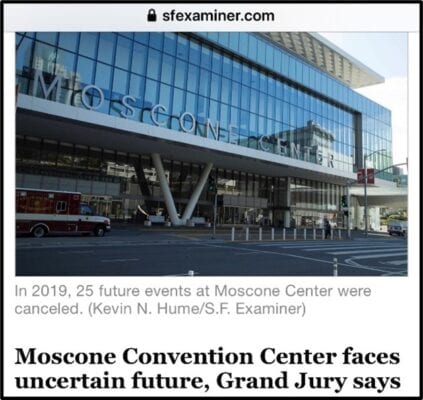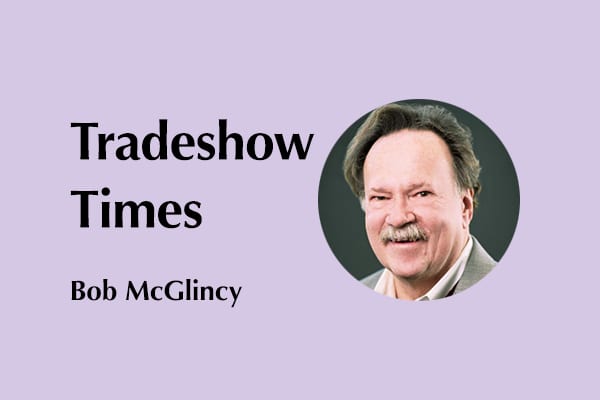by Bob McGlincy, director, business management at Willwork Global Event Services
 For decades, Orlando and San Francisco were two of the top ten busiest convention cities in the United States. During the ’80s, and some of the ’90s, San Francisco was a busier convention city than Orlando, but that is not the case today. In the 2017 CVENT “Top 50 US Meeting Destinations,” Orlando was rated as #1 and San Francisco was #14. (Other sources rate Las Vegas, and sometimes Chicago, as “busier” or “more popular” than Orlando).
For decades, Orlando and San Francisco were two of the top ten busiest convention cities in the United States. During the ’80s, and some of the ’90s, San Francisco was a busier convention city than Orlando, but that is not the case today. In the 2017 CVENT “Top 50 US Meeting Destinations,” Orlando was rated as #1 and San Francisco was #14. (Other sources rate Las Vegas, and sometimes Chicago, as “busier” or “more popular” than Orlando).
The Moscone Center opened in 1981 with 300,000 square feet of exhibit space. The facility expanded in 1991, 2003 and 2018. The Orange County Convention Center opened February 26, 1983, with 147,510 square feet of exhibit space, with expansions in 1989, 1990, 1996 and 2003. Today, Moscone has 505,000 square feet of space, the 30th largest center in the U.S., and the OCCC has 2,100,000 square feet of exhibit space, second largest in the country.
In December of 2020, the OCCC had its “busiest month since the onset of the pandemic” hosting 22,000 attendees, and providing show floor work for 753 local individuals. Last week, Surf Expo opened at the OCCC on Jan. 6.
On Dec. 29, 202 0, the San Francisco Examiner published an article stating that the Moscone Center generates approximately 20 percent of all travel and tourism revenue for the city. “But city officials have said that while they agree the convention center is vitally important to the city’s tourism, there’s a limit to what they can do to help it in the future.” A 19 person “Civil Grand Jury” panel spent a year analyzing the Moscone Center and convention business. The panel released their findings in October, and concluded that the overall economic impact of San Francisco’s convention business was “at risk.” They made a series of recommendations, “including setting aside an additional $2.5 million in subsidies.” However, according to the SF Examiner, “both the Board of Supervisors and Mayor … have concluded none of these recommendations can be implemented at this time.”
0, the San Francisco Examiner published an article stating that the Moscone Center generates approximately 20 percent of all travel and tourism revenue for the city. “But city officials have said that while they agree the convention center is vitally important to the city’s tourism, there’s a limit to what they can do to help it in the future.” A 19 person “Civil Grand Jury” panel spent a year analyzing the Moscone Center and convention business. The panel released their findings in October, and concluded that the overall economic impact of San Francisco’s convention business was “at risk.” They made a series of recommendations, “including setting aside an additional $2.5 million in subsidies.” However, according to the SF Examiner, “both the Board of Supervisors and Mayor … have concluded none of these recommendations can be implemented at this time.”
Another way to view the differences between the two cities, is to look at the economic impact generated by conventions. The OCCC has an annual economic impact of $3 BIL and the Moscone Center has an impact of approximately $1 BIL.
Why the difference in success between Orlando and San Francisco? There are many reasons. But one of the main ones, I think, is that the OCCC, in conjunction with elected officials, understand, promote and fund the importance of tradeshows. It’s not just about tourism and sun in the fun: it’s also about meetings and face-to-face events, and the impact on people and local economies. The OCCC is the second largest convention center in the country because they made it happen. Orlando is hosting safe, live events today (pictured right), because they are making it happen.
made it happen. Orlando is hosting safe, live events today (pictured right), because they are making it happen.
Unfortunately, the OCCC cannot continue to make expansion happen at this time: A proposed OCCC expansion of 200,000 square feet, scheduled to be completed in 2023, has been postponed due to the pandemic.
So, what can they do? What can Moscone do? What can all of us in the industry can do? We can get the word out concerning the monumental importance of the meetings and events industry.
Tradeshows create jobs. Millions of jobs. Tradeshows produce tax revenue for local, state, and federal governments—$130 billion in total tax revenue in 2019. A tradeshow is an engine that powers business and drives revenue.
We in the industry need to do a better job communicating all this.
Bob McGlincy is director, business management at Willwork Global Event Services. He can be contacted at Bob.McGlincy@willwork.com. Willwork creates engaging, energized, and exceptional event experiences.





























